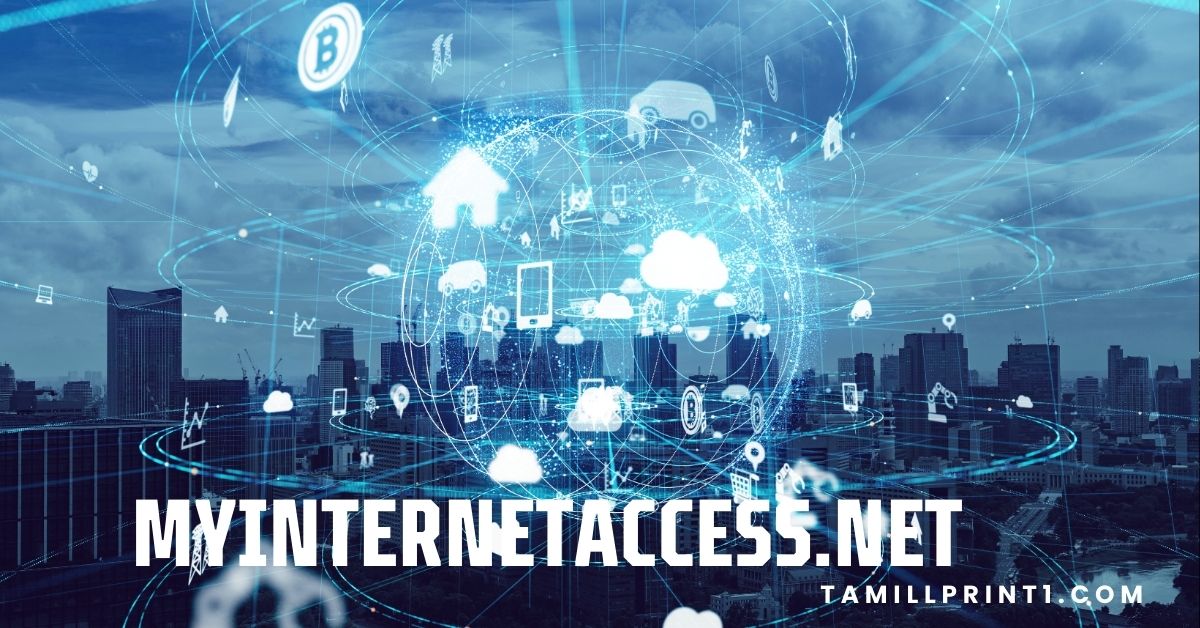In today’s digital world, a stable and fast internet connection is essential for both personal and professional use. Whether you are working from home, streaming movies, or just browsing the web, choosing the right internet service is crucial. MyInternetAccess.net is a platform dedicated to providing comprehensive information on internet connection options, helping users in the USA and France make informed decisions.
This article will explore different types of internet connections, their advantages and disadvantages, and factors to consider when selecting a provider. We will also discuss the state of internet access in the USA and France, along with practical tips for optimizing your connection.
What is MyInternetAccess.net?
MyInternetAccess.net is a web-based service that provides internet connectivity solutions. It mainly focuses on offering private, fast, and unrestricted access to the internet through virtual private networks (VPNs), secure browsing options, and data protection tools. It is designed for both individuals and organizations who want to improve their online privacy and accessibility.
Why Use MyInternetAccess.net?
There are many reasons why people around the world choose MyInternetAccess.net over other internet access solutions:
- Privacy Protection: It hides your online activity from hackers, advertisers, and even your internet provider.
- Access Blocked Content: You can visit websites and use services that might be blocked in your region.
- Safe Browsing: It helps prevent data theft on public Wi-Fi.
- Improved Speed: With servers around the world, it can improve browsing and streaming speeds.
- Ease of Use: Simple interface, easy to set up, even for beginners.
How MyInternetAccess.net Works
MyInternetAccess.net works mainly through its VPN technology. A VPN (Virtual Private Network) acts like a secure tunnel between your device and the internet. When you use MyInternetAccess.net, your data is encrypted and sent through one of their private servers before reaching the website or app you want to use.
Here’s a step-by-step breakdown:
- You open MyInternetAccess.net on your device.
- Choose a server location (for example, the USA or UK).
- Connect to the VPN.
- Browse the web safely and privately.
Key Features of MyInternetAccess.net
High-Speed Servers
MyInternetAccess.net provides multiple high-speed servers in different countries. These servers allow users to choose the best location for their needs, whether it’s for faster streaming or bypassing regional restrictions.
Data Encryption
Security is a major focus. All your data is encrypted using strong protocols, making it difficult for hackers or unwanted trackers to access your information.
No Logs Policy
MyInternetAccess.net follows a strict “no logs” policy. This means they do not track, collect, or share your browsing activity with anyone.
User-Friendly Interface
Even if you have never used a VPN or online security tool before, the design of MyInternetAccess.net makes it easy to use. The dashboard is clear, and the setup process is simple.
Compatibility With Multiple Devices
MyInternetAccess.net works on many devices, including smartphones, tablets, laptops, and desktop computers. It is also compatible with Android, iOS, Windows, and MacOS.
24/7 Customer Support
Users can reach out to their support team at any time via live chat or email.
Understanding Internet Connection Types
The type of internet connection you choose determines your browsing experience, download and upload speeds, and overall reliability. Here are the most common internet connection types:
1. Digital Subscriber Line (DSL)
- What is DSL? DSL (Digital Subscriber Line) uses traditional telephone lines to provide internet access. Unlike dial-up connections, DSL allows users to browse the internet and make phone calls simultaneously.
- Speed Range: 1 Mbps to 100 Mbps
- Availability: Found in most urban, suburban, and some rural areas
- Pros:
- Affordable pricing compared to fiber-optic or cable internet
- Available in many locations, including rural areas
- Uses existing telephone lines, making installation easier
- Cons:
- Speed decreases with distance from the provider’s central office
- Not ideal for high-bandwidth activities like gaming or 4K streaming

2. Cable Broadband
- What is Cable Broadband? This type of connection uses coaxial cables (the same used for cable TV) to provide high-speed internet.
- Speed Range: 25 Mbps to 1 Gbps
- Availability: Common in cities and suburban areas
- Pros:
- Faster than DSL and more stable
- Available in most urban and suburban areas
- Can handle multiple devices connected at once
- Cons:
- Speed can fluctuate during peak usage hours
- More expensive than DSL
3. Fiber-Optic Internet
- What is Fiber-Optic Internet? Fiber-optic internet transmits data through thin glass fibers using light signals, offering ultra-fast speeds.
- Speed Range: Up to 2 Gbps or higher
- Availability: Growing but mainly in urban areas
- Pros:
- Extremely fast download and upload speeds
- Reliable and less susceptible to slowdowns during peak hours
- Ideal for online gaming, video conferencing, and streaming
- Cons:
- Limited availability in rural areas
- More expensive compared to DSL and cable
Also Read: Rmozhazavizop: A Comprehensive Guide to Understanding and Embracing the Concept
4. Satellite Internet
- What is Satellite Internet? This connection type uses satellites orbiting the Earth to deliver internet access, making it ideal for remote locations.
- Speed Range: 12 Mbps to 100 Mbps
- Availability: Available everywhere, including rural areas
- Pros:
- Works in areas without wired connections
- No need for phone lines or cables
- Cons:
- High latency, making online gaming and video calls difficult
- Weather conditions can affect performance
- Expensive plans with data limits
5. Fixed Wireless Internet
- What is Fixed Wireless? It delivers internet service via radio signals from a local antenna to a receiver at your home.
- Speed Range: 5 Mbps to 50 Mbps
- Availability: Common in rural and underserved areas
- Pros:
- Quick installation and no need for phone lines or cables
- A good alternative where fiber or cable is unavailable
- Cons:
- Speed depends on distance from the provider’s tower
- Can be affected by obstructions like trees or buildings
6. Mobile Broadband (3G/4G/5G)
- What is Mobile Broadband? Mobile broadband uses cellular networks to provide internet access via a SIM card or mobile hotspot.
- Speed Range:
- 3G: Up to 10 Mbps
- 4G: Up to 100 Mbps
- 5G: Over 1 Gbps
- Availability: Dependent on mobile network coverage
- Pros:
- Portable and accessible anywhere with network coverage
- 5G offers ultra-fast speeds for streaming and gaming
- Cons:
- Data caps and expensive unlimited plans
- Speed varies based on signal strength and congestion
Also Read: From Severedbytes.net Blog: Tech Insights and Coding Tips
Factors to Consider When Choosing an Internet Service Provider (ISP)
Choosing the right ISP can be overwhelming. Here are key factors to consider:
- Speed Requirements: Determine how much speed you need based on your activities (e.g., streaming, gaming, remote work).
- Availability: Not all ISPs operate in every area, so check local options.
- Cost: Compare monthly fees, installation costs, and hidden charges.
- Reliability: Read customer reviews to check for frequent outages.
- Customer Support: A provider with good customer service can save you time and frustration.
Internet Access in the USA
In the United States, internet accessibility varies by region:
- Urban Areas: Fiber and cable internet are widely available with high speeds.
- Rural Areas: DSL, satellite, and fixed wireless are the primary options.
- 5G Expansion: Major carriers like Verizon and AT&T are rapidly expanding 5G networks.
Internet Access in France
France has a strong internet infrastructure:
- Fiber Expansion: The French government is promoting fiber-optic deployment nationwide.
- DSL and ADSL: Still used in rural areas but being replaced by fiber.
- Mobile Broadband: 4G coverage is extensive, with 5G rolling out.
Comparing MyInternetAccess.net with Other VPNs
Here is a simple comparison chart between MyInternetAccess.net and other popular VPN services:
| Feature | MyInternetAccess.net | VPN A | VPN B |
|---|---|---|---|
| Speed | Fast | Moderate | Fast |
| No Logs | Yes | Yes | No |
| Price | Affordable | Expensive | Cheap |
| Server Locations | Global | Limited | Global |
| Ease of Use | Very Easy | Complicated | Easy |
| Customer Support | 24/7 | Limited | 24/7 |
As shown, MyInternetAccess.net combines privacy, performance, and usability better than many competitors.
Security and Privacy Insights
Military-Grade Encryption
The encryption used by MyInternetAccess.net is similar to what is used by the military and financial institutions. This level of protection ensures your data is extremely secure.
DNS Leak Protection
DNS leaks can expose your browsing activities. MyInternetAccess.net has features that prevent this from happening.
Kill Switch Feature
If the VPN connection drops for any reason, the kill switch stops all internet activity until it’s safe again. This keeps your data from being exposed.
How MyInternetAccess.net Supports Internet Freedom
In many countries, the internet is heavily censored. MyInternetAccess.net gives people the power to access information freely. Whether it’s news, social media, or education, this tool helps promote digital freedom around the world.

Tips for Optimizing Your Internet Experience
- Upgrade Your Router: A modern router improves speed and range.
- Use Ethernet Cables: Wired connections are more stable than Wi-Fi.
- Limit Bandwidth Usage: Reduce background apps that consume bandwidth.
- Choose the Right ISP: Select a provider with good speeds and reliability.
Also Read: Yelaszozjindofo: Everything You Need to Know
Common Issues and How to Fix Them
Slow Speed
- Try switching to a different server
- Close other background apps
- Restart the app or your device
Connection Failure
- Check your internet connection
- Reinstall the app if needed
- Contact support if the problem continues
App Not Opening
- Update your device software
- Clear cache from app settings
Plans and Pricing
MyInternetAccess.net offers flexible pricing to suit all needs:
- Monthly Plan: Good for short-term users.
- Annual Plan: Saves more money in the long run.
- Family Plan: One account for multiple users.
Prices are competitive and affordable when compared to similar services.
Future of MyInternetAccess.net
MyInternetAccess.net continues to grow with more server locations, better technology, and improved customer service. The team behind the platform is committed to making internet access safer and more equal for all users around the world.
FAQs about MyInternetAccess.net
What is MyInternetAccess.net?
MyInternetAccess.net is an online portal providing information about internet options, helping users choose the best service.
Which internet connection is best for rural areas?
Satellite, DSL, and fixed wireless are the best choices for rural locations.
How can I check which ISPs are available in my area?
You can use online tools like broadband provider websites or government maps.
What is the fastest internet connection available?
Fiber-optic internet offers the highest speeds, reaching up to 2 Gbps or more.
Is 5G internet a good alternative to home broadband?
Yes, 5G can offer high speeds, but availability and data caps should be considered.
Conclusion
Choosing the right internet connection depends on your location, budget, and speed requirements. Whether you’re in the USA or France, options like fiber-optic, DSL, cable, and mobile broadband cater to different needs. By considering speed, reliability, and cost, you can select the best ISP for a seamless online experience. MyInternetAccess.net provides valuable insights to help you navigate the ever-evolving world of internet connectivity.







